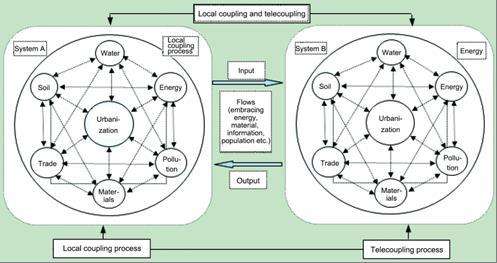The coupling relationship between urbanization and the eco-environment in urban agglomeration

The Beijing-Tianjin-Hebei urban agglomeration will be constructed as one of the largest urban agglomerations in the period of the 13th national five-year plan, and it is also the strategic core region for implementing the outline of collaborative development of Beijing, Tianjin and Hebei provinces and promoting the coordinated development of the Beijing-Tianjin-Hebei region. Recently, researches of CAS have revealed the local coupling and telecoupling relationship between urbanization and the eco-environment in the Beijing-Tianjin-Hebei urban agglomeration.
The research entitled "Analysis of emergy-based metabolic efficiency and environmental pressure on the local coupling and telecoupling between urbanization and the eco-environment in the Beijing-Tianjin-Hebei urban agglomeration", which was published in the SCIENCE CHINA Earth Sciences, is written by Prof. Fang Chuanglin and Dr. Ren Yufei from the institute of geographical sciences and natural resources, CAS.
An urban agglomeration is a large, open, and complicated system encompassing the cross-couplings of internal and external elements. Of these, internal elements refer to all those factors that can improve urban socioeconomic development within the city, while external elements include all the imported factors from outside of the city that could promote socioeconomic activities. Following expansion of urban agglomeration and its increasing demands on resources, internal elements are gradually unable to fulfill the needs of sustainable development, resulting in continuous importation of large numbers of external elements and stresses on the agglomeration ecosystem.
In this paper, researchers have creatively established a framework of local couplings and telecouplings between urbanization and the eco-environment. On the basis of urban emergy analysis, this research studied the Beijing-Tianjin-Hebei urban agglomeration and investigated the metabolic efficiency of local couplings and telecouplings between urbanization and the eco-environment as well as corresponding environmental pressures in the last 35 years spanning the period between 1980 and 2014.
This research has expanded relationships from local coupling into the new field of telecouplings, which will provide new research ideas for our understanding of the relationships between humans and the planet in the future. In this study, researchers demonstrate that external elements replaced internal ones and became dominant in the metabolic structure of the Beijing-Tianjin-Hebei urban agglomeration. At the same time, researchers conclude that the drop in metabolic emergy intensity accelerated while environmental load increased.
This results thus provide quantitative reference points for decision-making in effectively controlling the growth of foreign populations, gradually alleviating the non-capital functions of Beijing, improving and adjusting economic structures, raising economic operational efficiencies, solving environmental pollution, and promoting the coordinated development of Beijing, Tianjin, and Hebei.
More information: ChuangLin Fang et al, Analysis of emergy-based metabolic efficiency and environmental pressure on the local coupling and telecoupling between urbanization and the eco-environment in the Beijing-Tianjin-Hebei urban agglomeration, Science China Earth Sciences (2017). DOI: 10.1007/s11430-016-9038-6
Journal information: Science China Earth Sciences
Provided by Science China Press





















